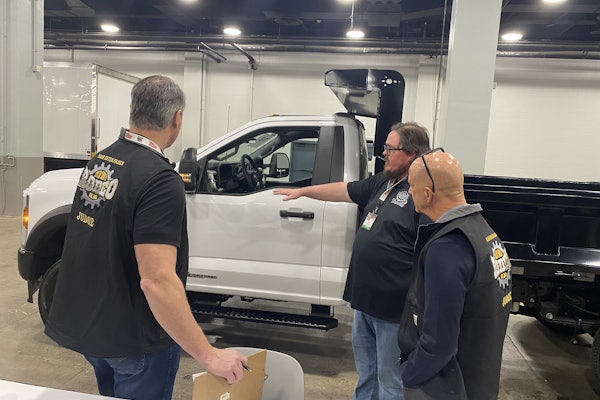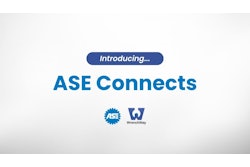The U.S. Environmental Protection Agency has hardly been kind to belts and hoses.
“Heat is the No. 1 enemy for any kind of rubber-type product,” says Ken Bridges, heavy-duty sales manager at Gates Corporation.
And extra heat is exactly what was created after the EPA reduced the allowable levels of NOx in truck exhaust. Once technologies such as exhaust gas recirculation (EGR) were introduced, temperatures under the hood climbed anywhere from 15 to 50 percent. The added equipment even filled some of the spaces that traditionally had been used to deliver a cooling supply of air.
That is not the only threat to the belts used in today’s heavy-duty engines. Improper tension, misaligned installations and changing pulley configurations have all added to the challenges. In addition to that, higher-amperage alternators and larger fan sizes are compounding the stresses under ideal situations.
Luckily, a simple visual inspection will offer an accurate indication of a belt’s condition, Bridges says. A serpentine belt has lost about 80 percent of its useful life if the grooves show signs of three to four cracks within the length of a credit card.
But when it comes to choosing a replacement, service technicians also should keep design issues in mind.
A serpentine belt actually consists of three separate layers. The “over cord” offers a layer to protect against contaminants such as oil or coolant. The cord, made of a material such as polyester or Kevlar, is the backbone of the belt that will handle the shock that comes with something like a starting engine. And the “under cord” that includes various grooves can be made of neoprene or an ethylene/propylene-based material known as EPDM. The latter material, says Bridges, is better able to address extreme variations in temperature.
Dave Wenger, the marketing manager for Veyance Technologies, which sells Goodyear Engineered Products, suggests that the physical shape also can make a difference in the overall life of the belt. “We have a cogged belt, and that cog adds more flexibility,” he explains. “When you add that flexibility, you reduce your heat buildup.” The cogs also can deflect the debris that would otherwise shred a belt to bits.
KEEP PROPER TENSION
In terms of the installation, the right amount of tension is also a good thing. After all, a slipping belt can reduce a fan’s cooling capacity, reduce the charge from an alternator, reduce the performance of the air conditioner and generate more of the heat that can damage bearings. An over-tightened belt, seized belt tensioner, oscillation (hammering) of the tensioner arm, and the hammering that damages a bearing cage can all present problems of their own.
Properly maintained automatic tensioners solve many issues. While a mere 40 percent of engines used them in 1998, these components now are found under the hoods of the vast majority of heavy-duty trucks, Bridges says.
Sales trends indicate that some installers fail to replace the tensioners whenever they replace a belt, but the belts and tensioners have a similar life expectancy and need to be replaced at the same time.
“Technicians are not paying much attention to the tensioner and they do fail,” Bridges explains, referring to rusted internal springs as an example of challenges that can emerge.
The condition of the devices can be monitored during a preventive maintenance check by taking off the belt and applying a ratchet to the tensioner to move it back and forth three or four times. “If it’s catching and not moving smoothly, the spring on the inside of the tensioner could be rusting or have lost its tension,” he says. Then spin the idler pulley to ensure that it spins freely.
The tensioner also should be securely fastened to the engine plate to ensure proper alignment. “If you see the belt on the over cord with the wear up the edge of the belt, there is a good indication the tensioner is misaligned.”
Meanwhile, a dampener found inside the tensioner acts like a brake shoe any time a load is put on the belt. If there is a lot of movement in the tensioner arm, the dampening device may have worn out.
When checking the automatic tensioner on a running engine, a technician’s stethoscope can be used to listen for squeaks, while the tracking of the belt should be checked by observing the position of the belt on the pulley. The belt should be tracking in one area of the pulley and not be spilling over the edges or wandering from side to side.
“There can be one, two, three tensioners on a drive. It can have one belt that is driving the alternator, going around the fan, and going around other components,” Bridges adds, referring to the stress and heat produced with every bend. “The more points in the drive can obviously affect the belt.”
“We’ve seen in certain applications that the design of the system is using smaller pulleys, and that smaller pulley puts more of a bend on the belt,” Wenger adds. That, in turn, leads to more heat.
Problems can be compounded by the misalignment of belts within the pulleys, whether it is in the form of parallel misalignment, where the sheaves are parallel but lying on different planes, or the angular misalignment that occurs when sheave shafts are not parallel to each other. Additional challenges emerge if the spacing or size of pulleys are mismatched, which can add more heat.
“One degree of misalignment adds 30 degrees of temperature to the belt,” Bridges explains.
While the most accurate indication of the pulley alignment comes with a laser alignment tool that tends to be used for industrial applications, a straight edge usually will be appropriate when working on trucks.
Of course, some older trucks still are equipped with V belts that require manually adjusted tension. That will involve using a proper tension gauge rather than pushing down on the belt with a thumb.
“Then run the belt in for about five to 15 minutes and then go back and check that tension. If it’s off plus or minus five to 10 pounds, you want to [adjust] tension,” Bridges stresses.
HOSES UNDER ATTACK
Hoses are also under attack from growing demands under the hood, placing an equal emphasis on their selection and installation.
The black hoses found in most applications usually will be made of EPDM, although silicone has been growing in popularity because it can handle intense heats in areas such as those around a turbocharger.
But not all rubber is created equal. Wenger suggests reading labels to ensure that the EPDM hose is actually an SAE 20R4 Type EC Class D-1 material. While a Class D-3 may have a higher heat rating, those who see such extreme temperatures have shifted to silicone. Any EPDM hose also should have an “ECR” label that identifies it is Electrochemical Degradation Resistant, to combat the internal damage from electrical charges that emerge when coolant and the cooling system’s hardware create an unwanted battery.
Still, EPDM can make a great choice for a hose at a lower cost. It also will form a tight bond with the stem on a radiator, Bridges says. “You almost have to pry it off, which is key in this industry because of cold coolant leaks.” Water also will permeate through the walls of a silicone hose at 10 to 15 times the levels of an EPDM hose, he adds, noting how that could present a challenge by altering the chemical balance of the mixtures that flow through them. To compound matters, silicone hoses are easily cut and damaged by abrasion.
Just like a belt, the condition of a hose often can be determined with a simple check. Any 90-degree bends should obviously be inspected for signs of cracks. But the true test of a hose will be in the way that it feels. The rubber will also get soft and spongy, or even begin to swell if it has been damaged by oil or coolant.
Keep in mind that the condition of an air conditioning system’s rubber hoses can even affect the performance of an air conditioner.
Refrigerant will gradually permeate through a rubber hose, explains Robert Gardiner, marketing manager of Red Dot, which produces A/C systems. “The result is poor cooling performance and a lack of lubrication for the A/C compressor.” It is why he stresses the importance of choosing a durable hose and proper fittings.
The debris that plugs water valves and damages heater cores can even be traced to hoses that are deteriorating from the inside out, adds Frank Burrow, Red Dot’s manager of product and warranty support. “That’s why it’s important to promote coolant changes at recommended intervals – and to remind vehicle owners to check hoses for a spongy feeling.”
Of course, any hose will only be as good as the connector that holds it in place. Clamps come in the form of a regular worm drive and the constant-tension models that include washers that ensure a consistent amount of force under all conditions, Bridges says. A worm gear will be fine with a small heater hose, as long as the proper torque spec’s are followed.
A third option comes in the form of the heat-shrink clamps that are tightened with nothing more than a heat gun. Even if they haven’t been completely tightened, the heat from an operating engine will cause these connectors to shrink further, Bridges says. “It will eliminate cold coolant leaks.”
Silicone hoses, meanwhile, should be attached with a lined clamp that is not serrated, so there are no worries about ripping into the material, Wenger suggests.
After all, these are the steps that will help to ensure belts and hoses are protected from any enemies that they face.








